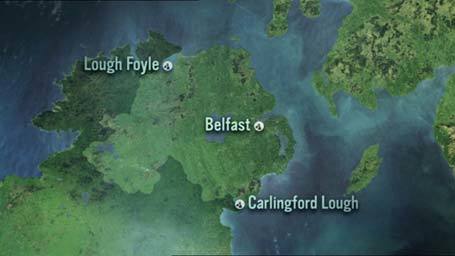The coast

Northern Ireland's coast has been shaped by a long and troubled history, but perhaps surprisingly the recent troubles have protected it. 30 years of neglect have saved it from some of the less desirable consequences of tourism and development. But now, as Northern Ireland gears up to make the most of its coastal attractions, this stunning landscape faces new challenges.
Strangford Lough - Co.Down
Strangford Lough is the largest sea lough in the British Isles, with more than 150 miles of its own coastline. The Lough supports over 2,000 marine species, and three-quarters of the world's population of light bellied Brent geese over-winter here. Strangford Lough is afforded every level of environmental protection possible in the UK, but it still faces serious threats from commercial fishing, pollution, and new development along its shores. Campaigners would like Strangford Lough to be made the UK's first Marine National Park. The Nature Reserve is mostly open to the public.
The Gobbins - Islandmagee
Victorian entrepreneurs realised the economic potential of our coastlines. They built holiday resorts and great piers to attract a new middle class with money to spend. In Northern Ireland railway magnate Dean Berkeley Wise constructed the most audacious cliff walk in these islands - nearly three miles of heart-stopping paths, bridges and tunnels along the magnificent Gobbins cliffs, just a few feet above the waves of the Irish Sea.
 |
Opened in 1902, the Gobbins Cliff Path was an immediate hit with the tourists, and remained one of Northern Ireland's most popular attractions until the outbreak of the Second World War caused its closure.
Today The Gobbins is derelict, inaccessible and forgotten. But it remains an amazing testament to the Victorian entrepreneurial spirit, which still brings so many of us to the coast. It is not open to the public
The Antrim Coast Road, Larne to Cushendun
The Antrim Coast Road cuts through some of the darkest events in Irish history. It was planned immediately after the 1798 Rebellion in Ireland, an event which led directly to the 1801 Act of Union, creating the United Kingdom of Great Britain and Ireland under one government in London.
The road was built in the 1830s, and hugs the coast around massive headlands and great bays for 22 miles. However, in 1845 its completion was overshadowed by a terrible disaster, the Great Irish Potato Famine. The road became an escape route for a starving population emigrating from this part of Co. Antrim.
Today the Antrim Coast road remains one of the most unique and scenic coastal drives in the UK.
Rathlin West Lighthouse, Rathlin Island
Rathlin West is an upside down lighthouse and is completely different from any other lighthouse guarding our coast. Built halfway up a sheer cliff face, the light, which is totally red, is at the bottom of the tower rather than at the top. The public cannot visit this lighthouse.